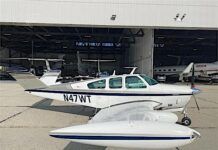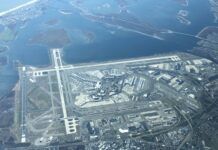The same runways that launched the atomic bomb raids on Hiroshima and Nagasaki could be refurbished to—in part—help defend Japan. According to a report in Stars and Stripes published today (Dec. 27), the United States Air Force (USAF) plans to return the North Airfield on Tinian Island to service, according to the commander of Pacific Air Forces Gen. Kenneth Wilsbach. Since last used in 1945, the four 8,500-foot runways have been overtaken by jungle growth.
The primary role of the wide-ranging redevelopment project is to provide dispersion points for U.S. aircraft in the Pacific region in the event of Chinese missile attacks. Brigadier Gen. Michael Zuhlsdorf, USAF deputy director of resource integration, said that plans call for an infrastructure build-up to support “agile combat deployment,” meaning the ability to move aircraft around quickly to disperse them from missiles in case of war with China. “We’re going to bring to life some mothballed bases that are out there,” Zuhlsdorf said.
Supporting U.S. forces in the area in this way is seen as a means to defend all U.S. allies in the region, including Japan, by deterring China “or any other country that considers challenges to a free and open Indo-Pacific,” said retired Air Force Lt. Gen. Dan Leaf, formerly deputy commander of the U.S. Pacific command.
Funding for the Tinian project is part of a wider effort to restore World War II-era air bases throughout the western Pacific region. As part of the recently passed National Defense Authorization Act for 2024, funds for the Tinian project include $26 million to develop airfields, $20 million for fuel farms, $32 million for parking aprons, $46 million for cargo pad and taxiway extensions, and $4.7 million for a maintenance and support facility.



































Interesting. I must be missing something as Guam is just a bit south of there and we have a military base on Guam.
Too much concentrated in Guam. The goal of the Tinian base is dispersal of aircraft around the region to reduce risk of loss.
There’s a lot of unused infrastructure at Tinian North field that could be brought back to use, most of the island’s 2000 or so inhabitants are on the south end where there is current airfield construction. But I think all this will be just for short term deployments as the harbor facility at Tinian isn’t very big. I just hope any new development respects the remaining historicial structures from WW2.
It took the lives of over 400 US Marines, sailors, and soldiers to take Tinian back from the Japanese in 1945, who themselves lost just shy of 10,000 souls in the battle.
Regarding Guam, the Japanese took it in 1941 at the cost of 1 life on their side, that’s how poor and neglected our defenses were. In 1944 it cost us 1,800 service members to take it back; 18,000 Japanese soldiers and sailors were killed in that battle.
The point is that Tinian’s military infrastructure can be returned to service and guarded effectively at minimal cost. It sounds like a good investment.
Very eerie to see this. My dad was in the US Navy 50th SeaBee’s (CBs) battalion on Tinian from June until late August 1945. According to him, his group was tasked with making the loading pits for the two atomic bombs.
Interesting also, if I read the numbers correctly, but the total cost of all the components in this project is barely more than one F-22. Don’t know if I’d call this ‘cheap’ insurance, but in the bigger scheme it seems the payoff in regional presence is pretty decent for the amount invested.
That does seem like a paltry budget for that much work. One wonders if it may be a propaganda feint to put the Chinese on notice. Regardless, I think it’s a good idea, if it comes to fruition.
I almost landed at Tinian one night, a long time ago (still classified).
This is only the beginning, we’ll be back at Clark and Subic in the Philippines soon, never should’ve left.
Guam and Okinawa are the most important bases in the South Pacific.
It feels like early 1941 all over again.
I hope not but I fear you may be right.
The Filipinos threw us out. There was no “choice” in that eviction.
Duterte spat on the USA. Literally, he spat during a speech. Duterte chose to suck up to Russia and China and that didn’t work out too well. In the meantime, John Kerry arrived with $650 million in foreign aid for the Philippines so Duterte took it.
The present Philippine Administration is welcoming the USA because we are the only country willing to defend them and bring money.
This is consistent with the Marine Corps program to shed some of its “mini-everything” structure by dropping things like tanks and the bridge-building units that support them, along with reductions in other things like jet fighters and heavy artillery. More emphasis will be put on enhanced mobility lightweight island-hopping force that would be an advantage in a Pacific conflict with China, who would hit hard at our power now concentrated at major forward island installations like Guam.
Would have be nice if they could have spent that money in the USA for 94UL tanks at GA airports instead of endless “posturing”.
I was a Naval Flight Officer assigned to VQ3 based on Guam in 1973 when I began pilot training at the Navy’s flying club. I flew from Guam to Tinian and landed multiple times in a Cessna 150. Seeing all the runways was always interesting along with avoiding the B52s heading to Vietnam out of Anderson AFB.